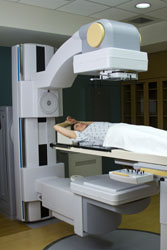Better radiation treatment for cancer
Intensive radiation therapy is often burdensome for cancer patients, prompting researchers to explore more efficient and less harmful ways of administering this treatment. The EU-funded project 'Adaptive and innovative radiation treatment for improving cancer patient's treatment outcome' (ARTFORCE) is working on enhancing treatment for locally advanced head/neck and lung cancer patients. The project is introducing new techniques that redirect the radiation to the most active part of the tumour, and finding ways to overcome tumour resistance. It is using image-guided and three-dimensional (3D) technology to distribute precise doses and ensure safe radiation delivery. Another major project objective is to re-evaluate the use of toxic medicines that are given in conjunction with radiation therapy, identifying at an early stage those patients who respond well to specific pharmaceutical interventions and those that do not. To achieve its aims ARTFORCE has brought together a powerful team of radiation oncologists, dosimetrists, radiographers, physicists and nuclear medicine specialists. It is now conducting clinical trials and selecting ideal patients, i.e. those who are sensitive to standard drug treatments given in combination with radiotherapy. In this context, the project has begun conducting two separate tests, a lung trial and a head and neck trial, with early results looking very promising indeed. Furthermore, these clinical trials are supported by fundamental research in molecular biology and radiation physics. To illustrate these two fields, changes in genes and proteins predicting treatment outcome in individual patients will be investigated; while in the radiation physics area, modern imaging techniques are explored to identify the precise tumour extension and its characteristics. Based on the concept of higher yet more targeted radiation doses, the expected results are nothing short of significantly better survival rates and fewer side effects. Lastly, the project has articulated more rigorous quality assurance procedures and methods to prevent radiation therapy accidents and enhance the treatment's accuracy. These developments represent very welcome news to certain cancer patients who may now have a much stronger chance of leading better, more comfortable lives.



